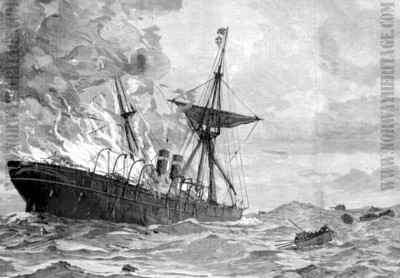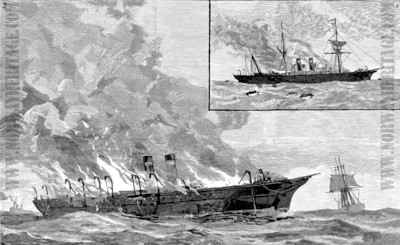BURNING OF THE STEAMSHIP CITY OF MONTREAL ON THE ATLANTIC OCEAN IN 1887
Transcribed by B. Solem February 2005 -
The ship caught fire at sea. She was carrying a cargo of 8,000 bales of raw American cotton, and was the 73rd ship with such cargo to catch fire in only 5 months. The passengers and crew were rescued by the S/S York City of the Furness Line. This is a transcript of an article in the London Illustrated News, August 27, 1887.
The steamship City of Montreal, of the Inman Line, was destroyed by fire on the 10th inst., 400 miles off the coast of Newfoundland, on her way from New York to Liverpool. She had on board twenty-seven second-class and 126 steerage passengers, and a general cargo; and her crew, with the officers, numbered ninety-four. All went well till the 10th inst., at nine p.m., when fire was discovered amongst the cargo of cotton. The fire hoses were instantly connected, fire annihilators and hand grenades were freely used, and every effort was made to extinguish the flames, but without success. The fire spread to such an extent, in the upper and lower tweendecks, that the captain saw that the ship was doomed to destruction. From the outbreak of the fire preparations were made to lower the boats, and to furnish them with provisions. At six o'clock on the morning of the 1'.th, the flames burst out of one of the after-hatches, and then the boats were lowered. The sea was high, and it was with much difficulty they were safely got into the water. All the women and children were first put into them and the male portion of the passengers and crew afterwards. All the boats had got safely away, when it was found that, by some oversight, about twenty people had been left on board. No. 3 boat thereupon returned, and took off six: and No. 5, with the fourth officer, took another six. At this time a barque was seen coming towards them; on her arrival, the boats put all their people on board her, and returned for those left behind on the burning steamer. One boat was missing-No. 8 and she was seen to put herself before the wind when she left the steamer and to run away from the burning vessel, in disobedience to the captain's orders. All that night was spent on the barque, which was a German vessel, bound from Charleston to London, with a cargo of turpentine. On the following morning, the steamer York City, of the Furness Line, from Baltimore, bound for London, which had been standing by the barque in the night, came close; and, with the aid of the boats of the City of Montreal, all the crew and passengers were soon transferred to her. The burning vessel was lost sight of at 4 a.m. on the 12th, and the York City proceeded direct for Queenstown, having in vain tried to find the missing boat. Although these efforts proved unsuccessful, it was hoped that those on the missing boat had been picked up, the accident having occurred in the track of steamers passing east and west. The smoke and heat affected the eyes of the captain, chief officer, bar-keeper, and those who were trying to put the fire out, rendering all blind for some time. In fact, the chief officer was led quite blind, and in great pain, off the burning ship, and did not recover his sight for two days. All are said to have behaved well under the circumstances, the passengers being cool and obedient and the crew steady; though all had to be done in a dense and blinding smoke and a high sea, there was no casualty attending the rescue. The passengers and crew lost everything they possessed except what they stood in. The origin of the fire is unknown; but the captain believes that it broke out in more than one place amongst the cotton. The steamer York City having transferred the crew and passengers of the ill-fated City of Montreal to the Inman Company's tender off Queenstown, she proceeded direct to London. The passengers have drawn up an address, which they have presented to Captain Land and the officers of the City of Montreal, stating and commenting on the circumstances, and concluding: "We not only exonerate the captain and officers from any blame, but we bear testimony that they did all that men could possibly do in the most trying situation, and notwithstanding much personal suffering."
The City of Montreal was built for the old Inman Company in 1872 by Messrs. Tod and MacGregor, of Glasgow. She was 2'J-tl tons net, and 4496 gross tonnage, 419 ft. long, 44 beam and 600 horsepower.
The missing boat No. 8 contained the following passengers :Samuel Kaufman, George Arnott, and James M'Kee, Kerward Woolton, Stephen Tupper, Simon Kowelsky, and S. Kachumeki: and six seamen-Henry Frazer, Charles Riddle, William Franey, Patrick Hughes (trimmer), Charles Smith (interpreter), and Thomas Wilberforce. Our Illustrations of the disaster are from sketches by Mr. George Moffat, carpenter on board the City of Montreal. An account of the manner in which it happened is given by the Rev. J. M. Donaldson, one of the passengers, in the daily papers.

Burning of the steamship City of Montreal on the Atlantic ocean:
The Mainmast going, two P.M. August 11.
From Sketches by the ship's Carpenter, George Moffat. 
Burning of the steamship City of Montreal on the Atlantic ocean:
The ship at Eleven A.M., August 11 (small picture), The last of the burning ship (Large picture)
From sketches by the ship's carpenter, George Moffat.
